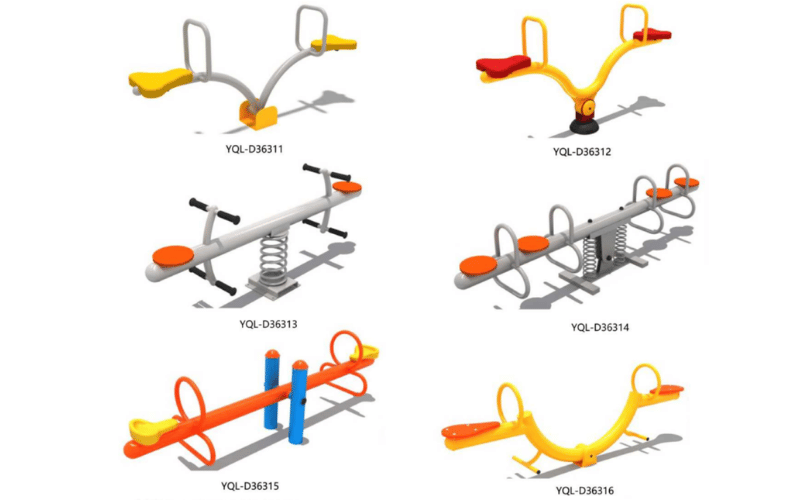Freestanding playground equipment offers a versatile and engaging way to enhance any play area. Unlike modular systems, these standalone structures function independently, making them easy to integrate into various spaces. Think of swings that invite children to soar, slides that spark endless laughter, climbers that challenge young adventurers, and spinners that bring a thrilling rush of motion. Each piece stands alone, yet together, they create a dynamic play environment.
Play isn’t just about fun—it’s a cornerstone of childhood development. Freestanding equipment supports physical growth by building strength, balance, and coordination. It also nurtures cognitive skills like problem-solving and spatial awareness while fostering social interactions as children share, take turns, and collaborate. These benefits make freestanding structures a valuable addition to schools, parks, and community spaces.
In this guide, I’ll walk you through the key benefits of freestanding playground equipment, explore the most popular types, and share practical tips for selecting and installing these structures. Whether you’re designing a new playground or upgrading an existing one, understanding these elements will help you create a space that’s safe, engaging, and built to last.
Table of Contents
ToggleBenefits of Freestanding Play Structures
Freestanding play structures bring unmatched versatility to playground design, offering a range of benefits that cater to various needs and spaces. From adaptability to cost-effectiveness, these structures provide practical solutions while delivering engaging play experiences for children.
Adaptability and Flexibility
Freestanding equipment adapts easily to different environments and evolves with your needs.
- Easy to Configure and Expand Over Time: Unlike integrated systems, freestanding structures allow you to add or rearrange components as your space or budget grows. For example, you can start with a set of swings and later add a climber or spinner without disrupting the existing layout. This modularity makes it simple to refresh the playground and keep it exciting for children.
- Suitable for Small or Irregular Spaces: Freestanding structures fit into spaces where larger systems might not work. For instance, a single slide or spinner can transform a narrow corner or oddly shaped area into a functional play zone. This flexibility ensures that even compact or unconventional sites can offer meaningful play opportunities.
Cost-Effectiveness
Freestanding play structures provide a budget-friendly way to create engaging play areas without compromising quality.
- Lower Initial Investment Compared to Integrated Systems: These standalone pieces often cost less upfront than large, interconnected systems. For example, purchasing a swing set or a single climber is more affordable than installing a sprawling multi-level play structure.
- Phased Purchasing Options for Budget Control: Freestanding equipment allows you to build your playground in phases. Start with a few key pieces and add more over time as funds become available. This approach helps you manage costs while steadily enhancing the play area.
Encouraging Diverse Activities
Freestanding structures encourage a wide range of movements and skills, keeping children active and engaged.
- Promotes Climbing, Swinging, Spinning, and Other Movements: Each piece of equipment focuses on specific types of play. Swings provide a soothing, rhythmic motion, while spinners offer a thrilling sense of speed. Climbers challenge children to test their strength and coordination, fostering physical growth and confidence.
- Supports Skill Development: Activities like balancing on a beam or climbing a rope ladder help children develop essential motor skills, spatial awareness, and problem-solving abilities. These skills translate into better physical and cognitive development over time.
Accessibility and Safety
Freestanding play structures prioritize inclusivity and safety, ensuring every child can participate in play.
- ADA-Compliant Designs for Inclusivity: Many freestanding pieces, such as accessible swings or ground-level sensory panels, cater to children with disabilities. These features create a welcoming environment where all children can play together.
- Safety Features Like Fall Zones and Durable Materials: Properly installed freestanding equipment includes safety measures like impact-absorbing surfacing and clear fall zones. Additionally, high-quality materials like powder-coated steel and UV-stabilized plastics ensure the equipment remains safe and durable, even under heavy use and harsh weather conditions.
Freestanding play structures combine adaptability, affordability, and inclusivity to create playgrounds that grow with your community’s needs. Each piece contributes to a dynamic, safe, and engaging play environment that children will enjoy for years to come.
Popular Types of Freestanding Play Equipment
Freestanding play equipment offers a variety of options to create a dynamic and engaging playground. Each type of equipment brings unique benefits, encouraging different forms of play and skill development. Let’s explore some of the most popular options and their specific advantages.
Swings
Swings are a playground classic, offering endless fun and opportunities for social interaction.
- Types: Belt swings are perfect for older children, while bucket or toddler swings provide safety for younger kids. Tire swings add a group play element, allowing multiple children to swing together.
- Benefits: Swings encourage unstructured play, where children can set their own pace and rhythm. They also promote social interaction as kids take turns or swing side by side, fostering communication and connection.
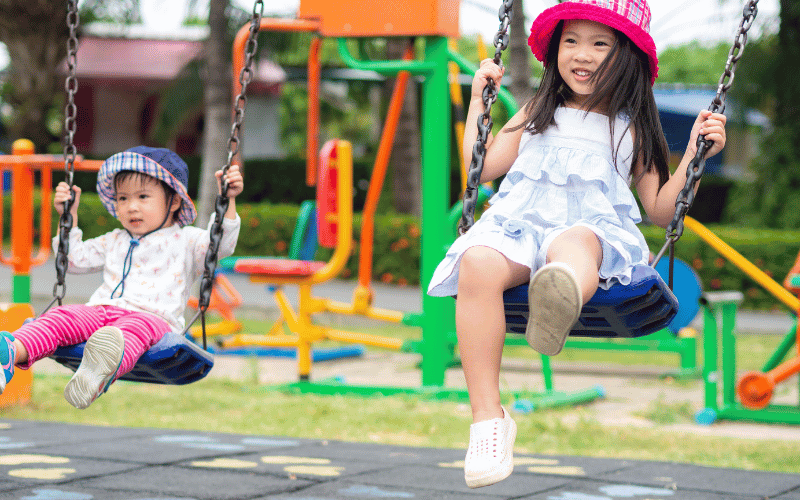
Climbers
Climbers challenge children to test their physical limits while building essential motor skills.
- Types: Net climbers provide a flexible, dynamic challenge, while boulders mimic natural rock formations for adventurous play. Geodesic domes offer a multi-directional climbing experience, encouraging creativity in how children navigate the structure.
- Benefits: Climbing builds strength, coordination, and problem-solving skills. It also boosts confidence as children conquer new heights and navigate complex paths.
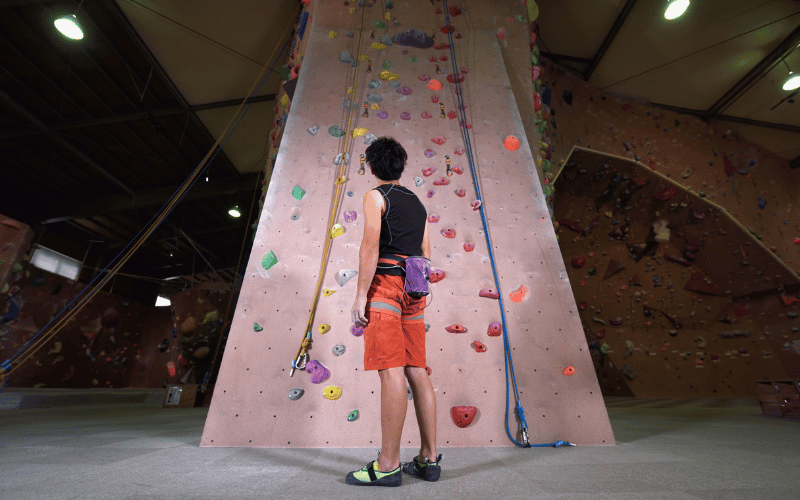
Spinners and Carousels
Spinners add an element of excitement and sensory stimulation to any playground.
- Types: Inclusive spinners, like large platforms with handrails, accommodate multiple children, including those with mobility challenges. Single-user spinners, such as stand-and-spin models, provide a more personal, thrilling experience.
- Benefits: Spinning enhances balance, spatial awareness, and sensory processing. Inclusive spinners also encourage group play, helping children develop social skills and teamwork.
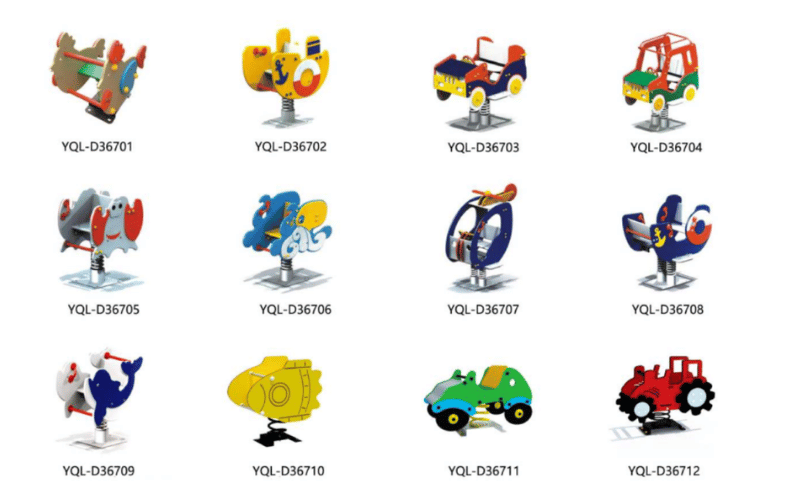
Slides
Slides remain a timeless favorite, offering a rush of excitement for children of all ages.
- Types: Straight slides are fast and straightforward, while spiral and wavy slides add twists and turns for extra fun. Embankment slides, built into slopes, provide a natural and accessible sliding option.
- Benefits: Slides are universally appealing and encourage repeated play. They also help children develop coordination and spatial awareness as they climb up and slide down.
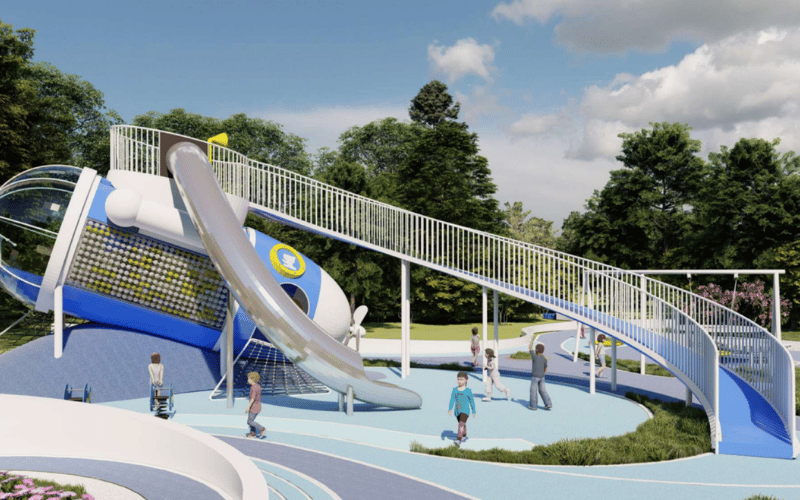
Seesaws
Seesaws bring a cooperative element to playgrounds, requiring children to work together for a balanced experience.
- Types: Traditional seesaws offer a classic up-and-down motion, while spring-based models add a layer of safety and flexibility, making them suitable for younger children.
- Benefits: Seesaws teach teamwork and collaboration as children coordinate their movements to keep the rhythm going. They also promote balance and core strength through the dynamic motion.
By incorporating a mix of these freestanding play structures, you can create a playground that caters to a wide range of interests, abilities, and developmental needs. Each piece adds its own personality to the space, ensuring children stay engaged and active.
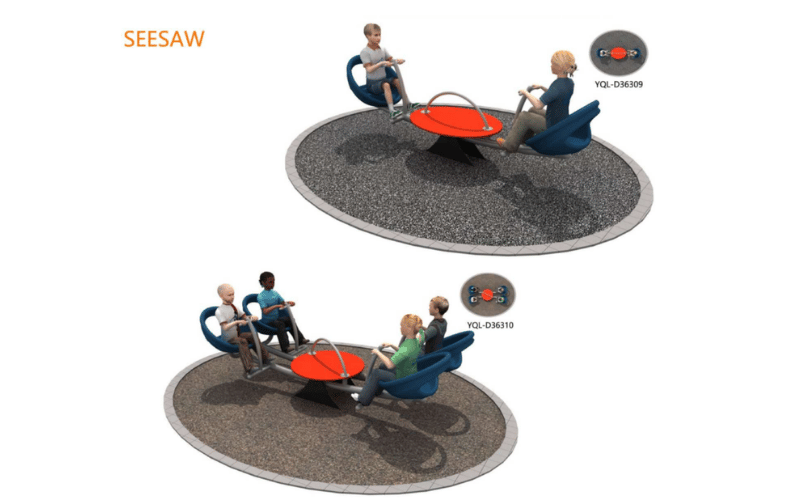
Selection and Installation Tips
Choosing and installing freestanding play equipment requires careful planning to ensure the playground meets the needs of its users while remaining safe and functional. From assessing community needs to preparing the site and planning the layout, every step plays a critical role in creating a successful play space.
Needs Assessment
Start by understanding who will use the playground and what they need to thrive.
- Evaluate Target Age Groups and Developmental Needs: Identify the primary age range of the children who will use the playground. For example, toddlers benefit from low-to-the-ground equipment like small slides and sensory panels, while older children need more challenging options like climbers and spinners. Consider developmental needs such as motor skills, social interaction, and sensory engagement to guide your equipment choices.
- Survey the Community for Preferences: Engage the community to gather input on what they want in a playground. Host a meeting, distribute surveys, or set up a suggestion box. For instance, parents might prioritize inclusive equipment, while children may request specific features like swings or spinners. This feedback ensures the playground reflects the community’s desires.
Site Preparation
A well-prepared site sets the foundation for a safe and durable playground.
- Level the Ground and Remove Obstacles: Clear the area of debris, tree roots, and uneven terrain. Use grading equipment to level the ground, ensuring a stable base for the equipment. For sloped areas, consider embankment slides or terraced play zones to make the most of the natural landscape.
- Choose Appropriate Safety Surfacing: Select surfacing that meets fall height requirements and suits your budget. Rubber tiles or poured-in-place rubber provide excellent shock absorption and accessibility, while engineered wood fiber or mulch offers a cost-effective alternative. Ensure the surfacing extends beyond the equipment’s fall zones for maximum safety.
Equipment Quality
Investing in high-quality equipment ensures the playground remains safe and functional for years to come.
- Prioritize Durable, Weather-Resistant Materials: Choose materials like powder-coated steel, UV-stabilized plastics, and pressure-treated wood to withstand heavy use and harsh weather. For example, metal components should resist rust, while plastic elements should retain their color and integrity under prolonged sun exposure.
- Ensure Compliance with Safety Standards: Verify that all equipment meets safety standards such as those set by the CPSC and ASTM. Request documentation from the manufacturer to confirm compliance, and ensure the equipment is installed according to the manufacturer’s guidelines.
Layout Planning
A thoughtful layout enhances the playground’s usability and safety.
- Group Equipment by Age Range: Designate separate zones for different age groups to prevent conflicts and ensure age-appropriate play. For instance, place toddler equipment in a quieter area, while reserving central spaces for older children’s climbers and spinners.
- Maintain Clear Sight Lines for Supervision: Arrange equipment to allow caregivers and supervisors to monitor the entire playground easily. Avoid placing tall structures in ways that block visibility.
- Separate Active and Quiet Play Areas: Create distinct zones for high-energy activities like swinging and climbing and quieter activities like sensory panels or shaded seating. This separation reduces the risk of collisions and provides options for children with different play styles.
By following these selection and installation tips, you can create a playground that is safe, engaging, and tailored to the needs of your community. Every detail, from the materials to the layout, contributes to a space where children can play, grow, and connect.
Maintenance and Longevity
Proper maintenance ensures your playground remains safe, functional, and inviting for years to come. By conducting routine inspections, addressing repairs promptly, and committing to long-term care, you can extend the life of your freestanding play equipment while minimizing risks.
Routine Inspections
Regular inspections are the backbone of playground maintenance, helping you catch issues before they become hazards.
- Check Bolts, Anchors, and Surfaces for Wear and Tear: Walk through the playground weekly to inspect bolts, screws, and anchors for looseness or corrosion. For example, swing chains often show signs of wear at connection points, so pay close attention to these areas. Examine surfaces for cracks, splinters, or sharp edges that could cause injuries.
- Monitor Safety Surfacing Depth and Integrity: Safety surfacing plays a critical role in injury prevention. For loose-fill materials like mulch or engineered wood fiber, measure the depth regularly to ensure it meets fall height requirements. Rake and redistribute the material as needed to maintain even coverage. For rubber tiles or poured-in-place surfacing, check for cracks, gaps, or lifting edges that could trip children.
Repair and Replacement
Timely repairs and replacements keep your playground safe and extend the life of its components.
- Replace High-Wear Parts Like Swing Seats and Bearings: Swings, spinners, and other moving parts experience the most wear. Replace swing seats, chains, and bearings as soon as you notice signs of damage or excessive wear. For example, if a swing chain shows rust or fraying, swap it out immediately to prevent accidents.
- Address Structural Issues Promptly: If you notice cracks in a climber’s frame or loose connections in a slide, don’t delay repairs. Structural issues can compromise the safety and stability of the equipment, so prioritize fixing them to avoid further damage or potential injuries.
Long-Term Care
Long-term care practices ensure your playground remains a valuable community asset for years to come.
- Schedule Annual Professional Audits: Hire a certified playground safety inspector (CPSI) to conduct a comprehensive audit at least once a year. These professionals can identify less obvious issues, such as hidden structural weaknesses or non-compliance with updated safety standards.
- Clean Equipment Regularly to Prevent Damage: Dirt, grime, and weather exposure can degrade materials over time. Clean metal and plastic components with mild soap and water, and avoid harsh chemicals that could corrode surfaces. For wooden elements, reseal or repaint them every few years to protect against moisture and UV damage.
By committing to regular maintenance and proactive care, you can ensure your playground remains a safe and enjoyable space for children. Every inspection, repair, and cleaning session contributes to the longevity and reliability of your equipment, making it a lasting investment in your community.
FAQs: Common Questions About Freestanding Play Structures
Q: What is the difference between integrated and freestanding equipment?
A: Integrated equipment connects multiple play elements into a single, cohesive system, such as a large play structure with slides, bridges, and climbers. Freestanding equipment, on the other hand, consists of individual pieces like swings, spinners, or climbers that function independently. Freestanding units offer more flexibility in layout and are easier to add or rearrange over time.
Q: How much space is needed for a single freestanding structure?
A: The space required depends on the type of equipment and its fall zone. For example, a standard swing set typically needs at least 20 feet of clearance in front and behind the swings, while a spinner may require a 6-8 foot radius around it. Always check the manufacturer’s guidelines for specific spacing requirements to ensure safety and compliance.
Q: What safety standards apply to spinners and other dynamic equipment?
A: Spinners and other dynamic equipment must meet ASTM F1487 standards, which cover public-use playground equipment. These standards address factors like fall height, entrapment risks, and structural integrity. Additionally, ensure the equipment complies with CPSC guidelines and includes proper safety surfacing to reduce injury risks.
Q: Can freestanding units be installed on grass?
A: While grass may seem like a convenient option, it does not meet safety standards for impact attenuation. Over time, grass can wear down, creating hard spots that increase the risk of injury. Instead, install freestanding units on approved safety surfacing like engineered wood fiber, rubber tiles, or poured-in-place rubber to provide adequate fall protection.
Q: What surfacing is best for freestanding play equipment?
A: The best surfacing depends on your budget, maintenance capacity, and accessibility needs. Rubber tiles and poured-in-place rubber offer excellent durability, accessibility, and shock absorption but come with higher upfront costs. Engineered wood fiber provides a more affordable option but requires regular raking and replenishment. Always choose surfacing that meets ASTM F1292 standards for impact attenuation and matches the fall height of your equipment.
Conclusion
Freestanding play structures offer unmatched versatility, allowing you to design a playground that adapts to your space, budget, and community needs. From swings that encourage social interaction to climbers that build strength and confidence, each piece brings unique benefits to children’s physical, cognitive, and social development. These structures fit seamlessly into small or irregular spaces, provide cost-effective options, and support diverse play activities for children of all abilities.
Now is the perfect time to transform your vision into reality. By creating a safe, engaging play space, you’re not just installing equipment—you’re building a foundation for joy, growth, and connection in your community. Start planning your playground project today and bring the magic of play to life.




